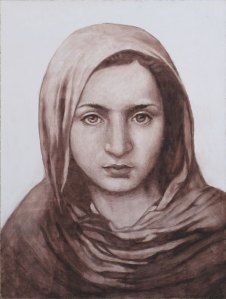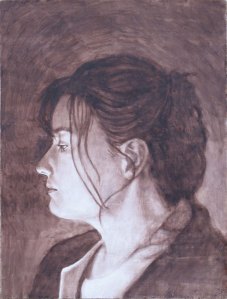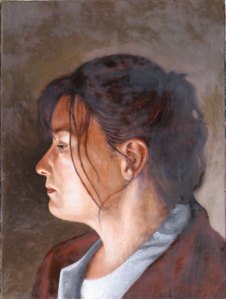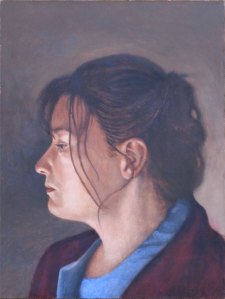This drawing is derivative of a copyrighted work of Steve McCurry.
When I write about Flemish Technique, I’m talking about techniques of the so-called “Flemish Primitives” of the early Renaissance, right at the dawn of oil painting as an art medium. I appended the adjective “old” to the title of this post to distinguish this Flemish Technique from other techniques of the same name, including Baroque Flemish portraiture, Dutch Rococo floral still lifes, and others newer still.
Oil painting in Flanders was really a mixed medium technique, and not really oil painting as we understand it today. Egg tempera paintings, as you may recall, were often begun with an ink drawing, sometimes a quite detailed one. Egg tempera paint was laid on, being the main component of the painting, and them sometimes an oil glaze or two was added at the end to enrich or deepen some colors. (Theophilus described the use of oil glazes over metallic surfaces some time before the Renaissance, so the idea had been around for a while.) Sometimes the oil glazes became more important; instead of being an egg tempera painting with some final glazes, a work might become essentially an oil painting with an ink and egg tempera underpainting. This is the basic technique as it was exported to Italy, before the invention of oil painting as we know it by Bellini and his compatriots. This information on Flemish Painting I first found at the great All the Strange Hours blog.
One can skip the egg tempera bit altogether, and simply paint in oil directly over the ink drawing, much of it still in glazes. This is what I’ve been working on. The ink drawing has been in homemade natural walnut ink, the same as I used here, but this time on a traditional gessoed panel. It’s nice to draw in ink on gesso, as it’s mostly erasable by scrubbing with a bristle brush; the only difficulty is in getting a flat wash. For the ink drawing, I’ve used a bristle brush, a fine sable ink brush, and the occasional quill pen. The picture at the top of the post shows the second ink drawing I completed, before the oil paint glazes have been applied. Here’s the first:
After the ink drawing, I laid down an imprimatura of linseed oil, because the gesso is so very absorbent that it can otherwise suck an oil paint layer dry, and also to lock in the ink drawing. Oil paints on gesso dry very quickly, so by the next day it was completely dry to the touch. I then laid down oil paints; some of them, as in the brown glaze over the hair, were able to remain completely transparent, so that the ink drawing really is an integral part of the final painting. For this stage I used a student palette of natural earths, bone black and lead white (pardon the quality of the pic here, the paint was still a bit wet in spots).
The final stage was for more highly-saturated glazes over the clothing, which again I could apply very quickly. For the blue I used natural ultramarine (lapis lazuli from Da Vinci); and I just couldn’t resist glazing with natural carmine over the red overshirt. (This is the Winsor & Newton Carmine oil paint I located a while back.)
All materials that were available in the Renaissance. Woo-hoo! (Well, the walnut ink is conjectural – but probable.) I will be doing one of these with egg tempera included; before that, I will complete in oil the drawing at top, and post in more detail about the technique of layering the oil paint.
Part II of Hand-mulling Paint is on the way too – promise!
Tags: Flemish technique, historical color, ink, oil painting, student palette, walnut ink




July 16, 2012 at 12:30 pm |
Walnut ink was definitely used in illuminated manuscripts.
July 16, 2012 at 4:39 pm |
David, thanks for stopping by and reading! I’ve been reading your blog for a while now. And thanks for the additional information. Last I’d read, it was buckthorn ink that was certain, and walnut ink probable but not certain – but I probably read that in Daniel Thompson, and I’m sure more information has come to light since then. Good to know!